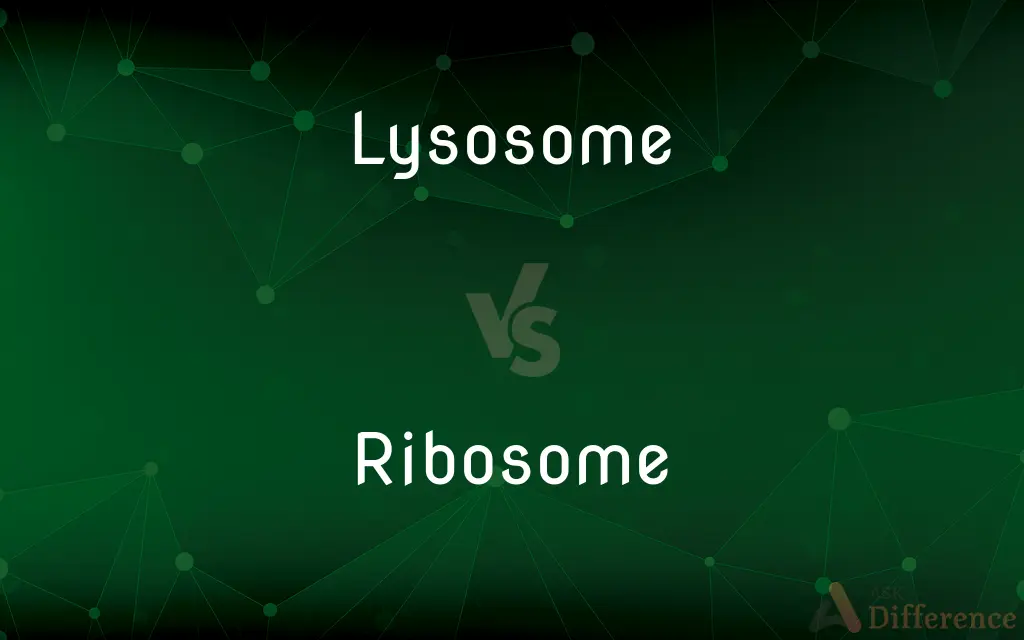Lysosome vs. Ribosome — What's the Difference?
Edited by Tayyaba Rehman — By Fiza Rafique — Updated on May 4, 2024
Lysosomes are cellular organelles responsible for waste disposal and recycling, while ribosomes are essential for protein synthesis.

Difference Between Lysosome and Ribosome
Table of Contents
ADVERTISEMENT
Key Differences
Lysosomes are membrane-bound organelles in eukaryotic cells known for their role in breaking down cellular waste, digesting unwanted materials, and recycling components within the cell. On the other hand, ribosomes are non-membrane-bound organelles found in all living cells, crucial for synthesizing proteins by translating mRNA into polypeptide chains.
Lysosomes contain enzymes that degrade biomolecules, a process vital for cellular health and turnover, whereas ribosomes read genetic instructions to assemble amino acids into proteins, essential for numerous cellular functions.
Lysosomes can be thought of as the cell’s recycling center, handling internal waste and worn-out organelles, while ribosomes function as protein factories, directly influencing growth and repair.
Lysosomes are particularly active in immune cells where they destroy pathogens, whereas ribosomes are ubiquitous, prominently located on the rough endoplasmic reticulum and in the cytosol, vital across all cell types.
Comparison Chart
Function
Degradation and recycling of cellular waste.
Synthesis of proteins from mRNA.
ADVERTISEMENT
Location
Enclosed within a membrane in eukaryotic cells.
Located in the cytosol and on the rough ER.
Composition
Contains hydrolytic enzymes.
Composed of rRNA and protein molecules.
Presence in Cells
Found only in eukaryotic cells.
Found in both eukaryotic and prokaryotic cells.
Role in Health
Involved in cellular cleanup and immune response.
Essential for growth, repair, and cellular functions.
Compare with Definitions
Lysosome
Cellular organelle containing digestive enzymes.
Lysosomes break down excess or worn-out cell parts.
Ribosome
Cell organelle that synthesizes proteins.
Ribosomes read mRNA to assemble proteins needed by the cell.
Lysosome
Functions as the waste disposal system of the cell.
Lysosomes digest bacteria ingested by immune cells.
Ribosome
Integral for gene expression.
Ribosomes translate genetic codes into functional protein structures.
Lysosome
Active in disease and stress response.
Lysosomes release enzymes to trigger programmed cell loss.
Ribosome
Composed of two subunits, large and small.
Ribosome subunits join to initiate protein synthesis.
Lysosome
Involves in cellular defense mechanisms.
Lysosomes destroy harmful bacteria trapped in phagosomes.
Ribosome
Universal in all living organisms.
Ribosomes perform the same protein synthesis role in plants and animals.
Lysosome
Recycles cellular materials.
Lysosomes recycle damaged organelles into basic components.
Ribosome
Found floating within the cytoplasm or attached to the ER.
Ribosomes on the rough ER make proteins for export.
Lysosome
A lysosome () is a membrane-bound organelle found in many animal cells. They are spherical vesicles that contain hydrolytic enzymes that can break down many kinds of biomolecules.
Ribosome
Ribosomes () are macromolecular machines, found within all living cells, that perform biological protein synthesis (mRNA translation). Ribosomes link amino acids together in the order specified by the codons of messenger RNA (mRNA) molecules to form polypeptide chains.
Lysosome
A membrane-bound organelle in the cytoplasm of most cells containing various hydrolytic enzymes that function in intracellular digestion.
Ribosome
A structure composed of RNA and protein, present in large numbers in the cytoplasm of living cells and serving as the site for assembly of polypeptides encoded by messenger RNA.
Lysosome
(cytology) An organelle found in all types of animal cells which contains a large range of digestive enzymes capable of splitting most biological macromolecules.
Ribosome
A small organelle found in all cells; involved in the production of proteins by translating messenger RNA.
Lysosome
An organelle found in the cytoplasm of most cells (especially in leukocytes and liver and kidney cells)
Ribosome
An organelle in the cytoplasm of a living cell; ribosomes attach to mRNA and move down it one codon at a time and stop until tRNA brings the required amino acid; when a ribosome reaches a stop codon it falls apart and releases the completed protein molecule for use by the cell;
The ribosome is the site of protein synthesis
Common Curiosities
How do lysosomes contribute to cellular health?
Lysosomes maintain cellular health by removing waste and breaking down complex molecules into reusable materials.
What are lysosomes and what do they do?
Lysosomes are organelles that digest and recycle cellular waste materials and unwanted substances.
What distinguishes lysosomes from other cellular organelles?
Lysosomes are distinguished by their ability to break down almost any kind of biomolecule, encapsulated by a protective membrane.
What is the primary function of ribosomes?
The primary function of ribosomes is to synthesize proteins by translating messenger RNA (mRNA).
Are ribosomes present in both prokaryotic and eukaryotic cells?
Yes, ribosomes are found in both prokaryotic and eukaryotic cells, essential for protein synthesis in all living organisms.
Can lysosome dysfunction affect human health?
Yes, dysfunction in lysosomes can lead to diseases such as lysosomal storage disorders, where buildup of waste affects cell function.
How do ribosomes affect cellular growth?
Ribosomes produce proteins that are crucial for cell growth, repair, and general maintenance.
What is the significance of ribosome location in the cell?
The location of ribosomes, either in the cytoplasm or on the rough ER, determines where the synthesized proteins are utilized or exported.
How do lysosomes interact with other cellular components?
Lysosomes interact with other organelles by receiving and breaking down materials transported to them for recycling.
Why are ribosomes important for medical research?
Ribosomes are targets for certain antibiotics and understanding their function can aid in developing new treatments.
Share Your Discovery

Previous Comparison
Bar vs. Pub
Next Comparison
Leader vs. ManagerAuthor Spotlight
Written by
Fiza RafiqueFiza Rafique is a skilled content writer at AskDifference.com, where she meticulously refines and enhances written pieces. Drawing from her vast editorial expertise, Fiza ensures clarity, accuracy, and precision in every article. Passionate about language, she continually seeks to elevate the quality of content for readers worldwide.
Edited by
Tayyaba RehmanTayyaba Rehman is a distinguished writer, currently serving as a primary contributor to askdifference.com. As a researcher in semantics and etymology, Tayyaba's passion for the complexity of languages and their distinctions has found a perfect home on the platform. Tayyaba delves into the intricacies of language, distinguishing between commonly confused words and phrases, thereby providing clarity for readers worldwide.
















































